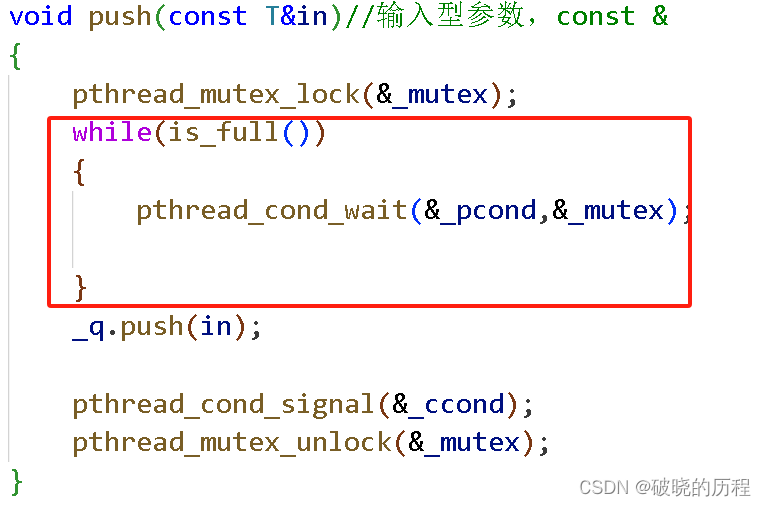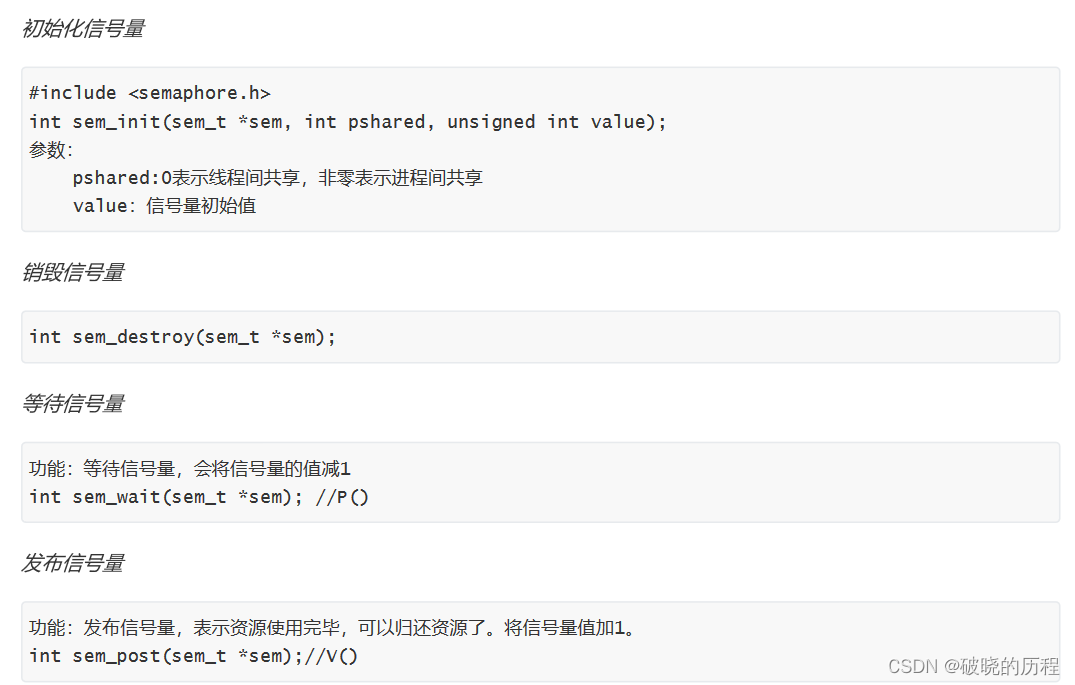

引言
今天,我们继续学习Linux线程本分,在Linux条件变量中,我们对条件变量的做了详细的说明,今天我们要利用条件变量来引出我们的另一个话题——信号量内容的学习。
1.复习条件变量
在上一期博客中,我们没有对条件变量做具体的使用,所以,这里我们通过一份代码来复习一下,接下来,我们实现基于BlockingQueue的生产者消费者模型。
1.1何为基于BlockingQueue的生产者消费者模型
BlockingQueue在多线程编程中阻塞队列(Blocking Queue)是一种常用于实现生产者和消费者模型的数据结构。其与普通的队列区别在于,当队列为空时,从队列获取元素的操作将会被阻塞,直到队列中被放入了元素;当队列满时,往队列里存放元素的操作也会被阻塞,直到有元素被从队列中取出(以上的操作都是基于不同的线程来说的,线程在对阻塞队列进程操作时会被阻塞)
如图:

1.2分析该模型
这里我想写多个生产线程和多个消费线程的模型
我们来分析一下。
- 首先生产任务的过程和消费任务的过程必须是互斥关系,不可以同时访问该队列(此时,这个队列是共享资源)。
- 当队列满时,生产线程就不能再生产任务,必须在特定的条件变量下等待;同理当队列为空时,消费线程就不能再消费任务,也必须在特定的条件变量下等待。
所以,类应这样设计:
template<class T>
class BlockQueue
{
public:BlockQueue(const int &maxcap=gmaxcap):_maxcap(maxcap){pthread_mutex_init(&_mutex,nullptr);pthread_cond_init(&_pcond,nullptr);pthread_cond_init(&_ccond,nullptr);}void push(const T&in)//输入型参数,const &{pthread_mutex_lock(&_mutex);while(is_full()){pthread_cond_wait(&_pcond,&_mutex);}_q.push(in);pthread_cond_signal(&_ccond);pthread_mutex_unlock(&_mutex);}void pop(T*out){pthread_mutex_lock(&_mutex);while(is_empty()){pthread_cond_wait(&_ccond,&_mutex);}*out=_q.front();_q.pop();pthread_cond_signal(&_pcond);pthread_mutex_unlock(&_mutex);}~BlockQueue(){pthread_mutex_destroy(&_mutex);pthread_cond_destroy(&_ccond);pthread_cond_destroy(&_pcond);}
private:bool is_empty(){return _q.empty();}bool is_full(){return _q.size()==_maxcap;}
private:std::queue<T> _q;int _maxcap; //队列中元素的上线pthread_mutex_t _mutex;pthread_cond_t _pcond; //生产者对应的条件变量pthread_cond_t _ccond;
};
由于我们不知道存储的数据类型,所以这里我们选择使用泛型编程的方式。
接下来就是要生产任务,为了可以观察到整个生产和消费任务的过程,我们可以生成两个随机数,然后进行运算。代码如下:
class CalTask
{using func_t = function<int(int, int, char)>;public:CalTask() {}CalTask(int x, int y, char op, func_t func) :_x(x),_y(y),_op(op),_callback(func){}string operator()(){int result=_callback(_x,_y,_op);char buffer[1024];snprintf(buffer,sizeof buffer,"%d %c %d=%d",_x,_op,_y,result);return buffer;}string toTaskstring(){char buffer[1024];snprintf(buffer,sizeof buffer,"%d %c %d=?",_x,_op,_y);return buffer;}
private:int _x;int _y;char _op;func_t _callback;
};
const char*oper="+-*/%";
int mymath(int x,int y,char op)
{int result=0;switch(op){case '+':result=x+y;break;case '-':result=x-y;break;case '*':result=x*y;break;case '/':if(y==0){cerr<<"div zero error"<<endl;result=-1;}else{result=x/y;}break;case '%':if(y==0){cerr<<"mod zero error"<<endl;result=-1;}else{result=x%y;}default:break;}return result;
}接下来,我们来写整体的代码。
1.3完整代码
我们要创建三个文件:BlockQueue.hpp Task.hpp Main.cc各文件内容如下所示:
BlockQueue.hpp
#pragma once
#include<iostream>
#include<pthread.h>
#include<cstring>
#include<unistd.h>
#include<cassert>
#include<queue>
using namespace std;
const int gmaxcap=100;
template<class T>
class BlockQueue
{
public:BlockQueue(const int &maxcap=gmaxcap):_maxcap(maxcap){pthread_mutex_init(&_mutex,nullptr);pthread_cond_init(&_pcond,nullptr);pthread_cond_init(&_ccond,nullptr);}void push(const T&in)//输入型参数,const &{pthread_mutex_lock(&_mutex);while(is_full()){pthread_cond_wait(&_pcond,&_mutex);}_q.push(in);pthread_cond_signal(&_ccond);pthread_mutex_unlock(&_mutex);}void pop(T*out){pthread_mutex_lock(&_mutex);while(is_empty()){pthread_cond_wait(&_ccond,&_mutex);}*out=_q.front();_q.pop();pthread_cond_signal(&_pcond);pthread_mutex_unlock(&_mutex);}~BlockQueue(){pthread_mutex_destroy(&_mutex);pthread_cond_destroy(&_ccond);pthread_cond_destroy(&_pcond);}
private:bool is_empty(){return _q.empty();}bool is_full(){return _q.size()==_maxcap;}
private:std::queue<T> _q;int _maxcap; //队列中元素的上线pthread_mutex_t _mutex;pthread_cond_t _pcond; //生产者对应的条件变量pthread_cond_t _ccond;
};
Task.hpp
#pragma once
#include <iostream>
#include <string>
#include <cstdio>
#include<string>
#include <functional>
using namespace std;
class CalTask
{using func_t = function<int(int, int, char)>;public:CalTask() {}CalTask(int x, int y, char op, func_t func) :_x(x),_y(y),_op(op),_callback(func){}string operator()(){int result=_callback(_x,_y,_op);char buffer[1024];snprintf(buffer,sizeof buffer,"%d %c %d=%d",_x,_op,_y,result);return buffer;}string toTaskstring(){char buffer[1024];snprintf(buffer,sizeof buffer,"%d %c %d=?",_x,_op,_y);return buffer;}
private:int _x;int _y;char _op;func_t _callback;
};
const char*oper="+-*/%";
int mymath(int x,int y,char op)
{int result=0;switch(op){case '+':result=x+y;break;case '-':result=x-y;break;case '*':result=x*y;break;case '/':if(y==0){cerr<<"div zero error"<<endl;result=-1;}elseresult=x/y;}break;case '%':if(y==0){cerr<<"mod zero error"<<endl;result=-1;}else{result=x%y;}default:break;}return result;
}
Main.cc
include "BlockQueue.hpp"
#include "Task.hpp"
#include<sys/types.h>
#include<unistd.h>
#include<ctime>
#include<iostream>
using namespace std;void *productor(void *bqs_)
{BlockQueue<CalTask> *bqs=static_cast<BlockQueue<CalTask>*>(bqs_);while(true){int x=rand()%10+1;int y=rand()%5+1;int opercode=rand()%(sizeof(oper));CalTask T(x,y,oper[opercode],mymath);bqs->push(T);cout<<"生产任务: ";cout<<T.toTaskstring()<<endl;sleep(1);}
}
void *consumer(void *bqs_)
{BlockQueue<CalTask>*bqs=static_cast<BlockQueue<CalTask>*>(bqs_);while(true){CalTask T;bqs->pop(&T);cout<<"消费任务: ";cout<<T()<<endl;}
}
int main()
{BlockQueue<CalTask> bqs;pthread_t p[5];pthread_t c[5];for(int i=0;i<5;i++){pthread_create(&p[i],nullptr,productor,&bqs);pthread_create(&c[i],nullptr,consumer,&bqs);}for(int i=0;i<5;i++){pthread_join(p[i],nullptr);pthread_join(c[i],nullptr);}
}
在代码中,有几个点需要注意一下:
第一点:

pthread_cond_wait的第二个参数一定是我们正在使用的互斥锁,这个函数在被运行时,会以原子性的方式将锁释放,然后将自己挂起,等待被条件变量唤醒。该函数在被唤醒时,会自动重新获取持有的锁,然后继续向下执行。
假如数个生产者线程一起被唤醒,然后先后持有锁,接着继续生产任务,当队列剩余的空间小于这些生产者生产的任务时,就会出现问题,所以让所有被唤醒的线程先通过while循环,如果有剩余的空间,再进行任务的生产活动。
生产线程这样处理,消费线程也要这样处理
大家可以在自己试这敲一下,有问题可以在评论区和我交流。
接下来,我们来查找一下这些代码有哪些"不足的地方"
2.代码中的“不足”
一个线程在操作临界资源时,临界资源必须是满足条件的,然后线程才能对临界资源进行操作。比如:在如上代码中,生产者线程只有在队列(临界资源)有剩余空间的条件下,才能进行下一步操作。
可是,临界资源是否满足生产和消费的条件,我们不能事前得知,只等进入临界资源后,再进行进一步的检测。
所以,一般访问临界资源的过程为:先加锁,再检测,如果条件满足,就进行下一步的操作;反之,就将该线程挂起,释放锁,然后挂起等待,等到条件满足时,重新获得锁,接着进行下一步操作。
因为不可能事先得知是否满足条件,所以我们只能先加锁,进入临界资源内部进行检测。
只要我们申请了信号量,就默认对这部分资源的整体使用,但通常情况下,我们使用的仅仅是临界资源的一小部分。
实际情况中,有没有可能不同的线程访问临界资源不同部分的情况,有可能。所以,前辈大佬们给出了一种解决方案——信号量。
3.信号量
3.1什么是信号量
信号量的本质是一把计数器,一把衡量临界资源多少的计数器。只要拥有信号量,就在未来一定能够拥有临界资源的一部分。
申请信号量的本质:就是对临界资源的预定机制。
比如:我想去看电影,首先我要买票。我一旦买到票,无论我去不去看电影,都会有一个位置属于我。买票的过程==申请信号信号量的过程。
所以,在访问临界资源之前,我们可以申请信号量。通过申请信号量,我们就可以获知临界资源的使用情况。①只要申请成功,就一定有我可以访问的资源。②只要申请失败,说明条件不就绪,只能等待。如此,就不需要进入临界资源再进行检测了。
3.2信号量的相关接口

如上这些借口如果调用成功的话,返回0;调用失败的话,返回-1,并且错误原因被设置。
我们知道信号量的本质是一把计数器,所以信号量必须可以进行递增和递减的操作。
- 信号量-1:申请资源,其过程必须是原子性的。简称P操作。
- 信号量+1:归还资源,其过程必须是原子性的。简称V操作。
所以,信号量的核心操作:PV原语。
接下来,我们就使用信号量来完成我们的基于环形队列的生产消费模型。
3.3用信号量来实现基于环形队列的生产消费模型
3.3.1对环形队列的简单介绍
相信大家在C++学习期间到都模拟实现过环形队列队列。如图:

环形队列的逻辑结构为环形,但其存储结构实际上就是队列,其实就是一个数组,只不过用下标不断的%上队列的长度。
大家在模拟实现环形队列时,大家必定遇到的问题是:当rear==front时,究竟是环形队列已满还是环形队列为空呢?其实,这个问题有多种处理方式,今天就不讲了。
今天,我们的基于环形队列的生产消费模型必须遵守哪些规则呢?
我们来讲一个故事:
张三和李四在一个房间里做游戏,这个房间里有一张大圆桌,桌子上有很多的盘子。规定张三往每个盘子里放一个桃子🍑,然后李四在后边吃桃子🍑,由于李四还要吃桃子,所以速度一定比张三放的速度满。

总结一下,我们发现张三和李四必须满足这些规律:
- 李四不可以超过张三——消费者不可以超过生产者。
- 张三不可以把李四套一个圈——生产者不可以把消费者套一个圈。
- 张三和李四什么时候在一起?①盘子全为空,张三和李四在一起,张三先运行(生产者先运行)。②盘子全为满,张三和李四在一起,李四先运行(消费者先运行)。③其他情况,张三和李四指向不同的位置。
我们将这些规则迁移到环形队列的生产消费模型,就是生产消费模型应该遵守的规则:
①消费者不能超过生产者。②生产者不能把消费者套一个圈。③生产者和消费者什么情况下会在一起呢?空的时候和满的时候,对应不同的处理方式。④只要生产者和消费者指向不同的位置,就可以实现生产者和消费者的并发执行。只有在为空和为 满时,才会出现同步和互斥问题。
那这些规则由什么来保证呢?信号量。信号量是表征临界资源中资源数目的。
1.对于生产者而言,看中的是队列中的剩余空间——空间资源定义一个信号量。
2.对于消费者而言,看中的是队列中的数据——数据资源定义一个信号量。
接下来,我们基于这份伪代码来理解一下,看看能否满足我们的规则。
 生产者关注的是队列里的剩余空间,在队列为空时剩余空间为10,所以生产者可以顺利申请到信号量。但是由于空间中这部分资源已经被占用,所以无法归还。但是消费者所关注的队列中的数据资源不知不觉中已经多了一份。所以对消费者信号量应进行V操作。
生产者关注的是队列里的剩余空间,在队列为空时剩余空间为10,所以生产者可以顺利申请到信号量。但是由于空间中这部分资源已经被占用,所以无法归还。但是消费者所关注的队列中的数据资源不知不觉中已经多了一份。所以对消费者信号量应进行V操作。
消费者关注的是队列中的数据资源,队列刚开始为空时,数据资源为0,消费者申请失败。等到生产者申请神域空间成功后,生产了数据。所以消费者可以成功申请到数据资源信号量,然后消费数据。但不知不觉,队列中的剩余空间多了一份,所以应对剩余空间资源的信号量进行V操作。
若队列满时,剩余空间信号量为0,生产者申请信号量失败。此时,数据资源信号量为满,消费者可以申请到信号量,从而进行操作。所以必须消费者先运行。
若队列空时,数据资源信号量为0,消费者申请信号量失败。此时,剩余空间信号量为满,生产者可以申请到信号量,从而进行操作。所以必须生产者先运行。
所以,这伪代码完全符合我们的规则。接下来,我们编写单生产进程和单消费进程的代码。
编写代码
我们创建三个源文件:RingQueue.hpp main.cc Task.hpp
Ringqueue.hpp:
#pragma once#include <iostream>
#include <vector>
#include <cassert>
#include <semaphore.h>
#include <pthread.h>static const int gcap = 5;template<class T>
class RingQueue
{
private:void P(sem_t &sem){int n = sem_wait(&sem);assert(n == 0); // if(void)n;}void V(sem_t &sem){int n = sem_post(&sem);assert(n == 0);(void)n;}
public:RingQueue(const int &cap = gcap): _queue(cap), _cap(cap){int n = sem_init(&_spaceSem, 0, _cap);assert(n == 0);n = sem_init(&_dataSem, 0, 0);assert(n == 0);_productorStep = _consumerStep = 0;pthread_mutex_init(&_pmutex, nullptr);pthread_mutex_init(&_cmutex, nullptr);}// 生产者void Push(const T &in){// ?: 这个代码 有没有优化的可能// 你认为:现加锁,后申请信号量,还是现申请信号量,在加锁?P(_spaceSem); // 申请到了空间信号量,意味着,我一定能进行正常的生产pthread_mutex_lock(&_pmutex); _queue[_productorStep++] = in;_productorStep %= _cap;pthread_mutex_unlock(&_pmutex);V(_dataSem);}// 消费者void Pop(T *out){// 你认为:现加锁,后申请信号量,还是现申请信号量,在加锁?P(_dataSem);pthread_mutex_lock(&_cmutex);*out = _queue[_consumerStep++];_consumerStep %= _cap;pthread_mutex_unlock(&_cmutex);V(_spaceSem);}~RingQueue(){sem_destroy(&_spaceSem);sem_destroy(&_dataSem);pthread_mutex_destroy(&_pmutex);pthread_mutex_destroy(&_cmutex);}
private:std::vector<T> _queue;int _cap;sem_t _spaceSem; // 生产者 想生产,看中的是什么资源呢? 空间资源sem_t _dataSem; // 消费者 想消费,看中的是什么资源呢? 数据资源int _productorStep;int _consumerStep;pthread_mutex_t _pmutex;pthread_mutex_t _cmutex;
};
Task.hpp
#pragma once#include <iostream>
#include <string>
#include <cstdio>
#include <functional>class Task
{using func_t = std::function<int(int,int,char)>;// typedef std::function<int(int,int)> func_t;
public:Task(){}Task(int x, int y, char op, func_t func):_x(x), _y(y), _op(op), _callback(func){}std::string operator()(){int result = _callback(_x, _y, _op);char buffer[1024];snprintf(buffer, sizeof buffer, "%d %c %d = %d", _x, _op, _y, result);return buffer;}std::string toTaskString(){char buffer[1024];snprintf(buffer, sizeof buffer, "%d %c %d = ?", _x, _op, _y);return buffer;}
private:int _x;int _y;char _op;func_t _callback;
};const std::string oper = "+-*/%";int mymath(int x, int y, char op)
{int result = 0;switch (op){case '+':result = x + y;break;case '-':result = x - y;break;case '*':result = x * y;break;case '/':{if (y == 0){std::cerr << "div zero error!" << std::endl;result = -1;}elseresult = x / y;}break;case '%':{if (y == 0){std::cerr << "mod zero error!" << std::endl;result = -1;}elseresult = x % y;}break;default:// do nothingbreak;}return result;
}
main.cc
#include "RingQueue.hpp"
#include "Task.hpp"
#include <pthread.h>
#include <ctime>
#include <cstdlib>
#include <sys/types.h>
#include <unistd.h>std::string SelfName()
{char name[128];snprintf(name, sizeof(name), "thread[0x%x]", pthread_self());return name;
}void *ProductorRoutine(void *rq)
{// RingQueue<int> *ringqueue = static_cast<RingQueue<int> *>(rq);RingQueue<Task> *ringqueue = static_cast<RingQueue<Task> *>(rq);while(true){// version1// int data = rand() % 10 + 1;// ringqueue->Push(data);// std::cout << "生产完成,生产的数据是:" << data << std::endl;// version2// 构建or获取任务 --- 这个是要花时间的!int x = rand() % 10;int y = rand() % 5;char op = oper[rand()%oper.size()];Task t(x, y, op, mymath);// 生产任务ringqueue->Push(t);// 输出提示std::cout << SelfName() << ", 生产者派发了一个任务: " << t.toTaskString() << std::endl;// sleep(1);}
}void *ConsumerRoutine(void *rq)
{// RingQueue<int> *ringqueue = static_cast<RingQueue<int> *>(rq);RingQueue<Task> *ringqueue = static_cast<RingQueue<Task> *>(rq);while(true){//version1// int data;// ringqueue->Pop(&data);// std::cout << "消费完成,消费的数据是:" << data << std::endl;// sleep(1);// version2Task t;//消费任务ringqueue->Pop(&t);std::string result = t(); // 消费也是要花时间的!std::cout << SelfName() << ", 消费者消费了一个任务: " << result << std::endl;// sleep(1);}
}int main()
{srand((unsigned int)time(nullptr) ^ getpid() ^ pthread_self() ^ 0x71727374);// RingQueue<int> *rq = new RingQueue<int>();RingQueue<Task> *rq = new RingQueue<Task>();// 单生产,单消费,多生产,多消费 --> 只要保证,最终进入临界区的是一个生产,一个消费就行!// 多生产,多消费的意义??pthread_t p[4], c[8];for(int i = 0; i < 4; i++) pthread_create(p+i, nullptr, ProductorRoutine, rq);for(int i = 0; i < 8; i++) pthread_create(c+i, nullptr, ConsumerRoutine, rq);for(int i = 0; i < 4; i++) pthread_join(p[i], nullptr);for(int i = 0; i < 8; i++) pthread_join(c[i], nullptr);delete rq;return 0;
}
大家可以自己敲一敲,试一下。
写到这里,这篇博客就结束了,下篇博客我们再见。

:动态规划——最长公共子序列)
: 数据兼容级别有效值为100、110或120)


)





】:基于特征点匹配的图像配准)






